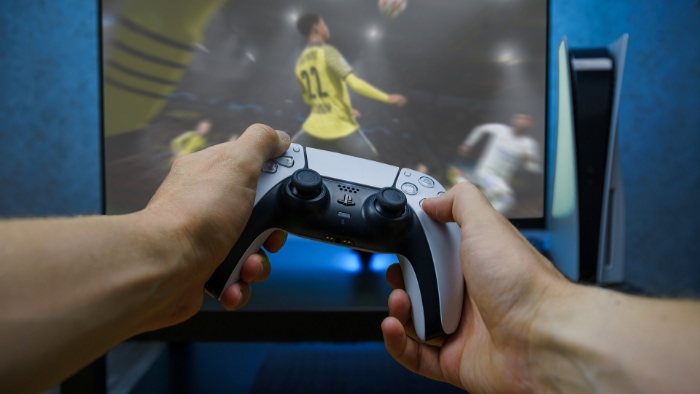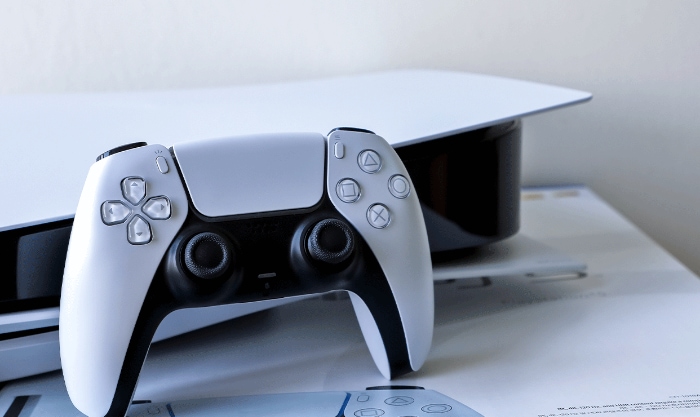PS5 Backward Compatibility: Reliving Old Games

Backward compatibility has long been a coveted feature in the gaming world. It acts as a bridge between generations, allowing players to dive back into their favorite games from yesteryears without needing to maintain a collection of older consoles.
As technology advances and consoles evolve, this feature becomes more significant, not only in preserving gaming history but also in ensuring a seamless transition for gamers upgrading to the latest hardware. PlayStation, with its rich history spanning several iconic consoles, naturally garners attention when a new model is launched.
As the PlayStation 5 (PS5) took the world by storm, one question echoed among many: “Is the PS5 backward compatible?” This article delves into that very query, shedding light on the PS5’s ability to play games from its predecessors.
PS5’s Backwards Compatibility Features
Backward compatibility stands as a testament to the enduring appeal of video games, with classic titles remaining as relevant and beloved today as when they first hit the market. The PlayStation 5 (PS5) has not overlooked this fact.
Sony’s next-generation console has included several features to ensure gamers can still enjoy their expansive library of PS4 titles, and in some cases, even more.
Understanding PS5’s Approach to Backward Compatibility
Sony has always been at the forefront of gaming innovation, and with the PS5, they’ve continued their tradition of honoring past titles. The PS5 is designed primarily with PS4 games in mind, ensuring most titles from the previous generation are playable.
Supported PS4 Games on PS5
The vast majority of PS4 games are playable on the PS5. This means that out of the thousands of games available on the PS4, most will run seamlessly on the PS5.
However, there might be a few exceptions due to licensing or technical issues. It’s always a good idea to check Sony’s official list if unsure about a particular title.
Physical vs. Digital Games
Both physical discs and digital downloads of PS4 games can be played on the PS5. If you own a physical PS4 game, simply insert the disc into the PS5 (provided you have the disc version of the console).
For digital titles, they can be downloaded directly from your library on the PlayStation Network.
Enhancement Features for PS4 Games
The PS5 doesn’t just allow you to play PS4 games; it also enhances them. Thanks to the improved hardware, many PS4 games will experience faster load times, smoother gameplay, and in some cases, improved resolutions and graphics when played on the PS5.
Earlier PlayStation Games
While the PS5’s backward compatibility is primarily focused on PS4 titles, there have been questions about its support for PS3, PS2, or even PS1 games. As of now, there isn’t native support for these older generations.
Gamers hoping to revisit classics from these eras might have to look at other methods or hope for future updates or remastered versions.
Challenges and Limitations
While the PS5 offers extensive support for PS4 titles, there are some challenges. Some games might require updates to be compatible with the PS5.
Additionally, certain in-game features or functionalities that rely on the PS4’s unique hardware might not work perfectly on the new console.
By embracing backward compatibility, the PS5 ensures a bridge between generations, celebrating the vast gaming history while also looking ahead to the future. With this feature, players can transition to the new console without leaving their favorite titles behind.
Why is Backwards Compatibility Important?
The evolution of gaming consoles is a thrilling journey, marked by leaps in technology and design. However, as we embrace the new, it’s essential not to forget the classics that paved the way.
Backwards compatibility is that golden thread which connects the past to the present, ensuring that cherished games remain accessible even as hardware changes. But why does this feature matter so much to both developers and gamers?
Preserving Gaming History
Video games are not just products; they are experiences, memories, and for many, a significant part of their cultural heritage. By supporting older titles, backwards compatibility ensures that newer generations can experience the milestones of gaming history firsthand.
Financial Considerations for Gamers
Investing in a game library is a significant commitment for many players. The ability to play older games on a new console ensures that gamers get maximum value from their purchases.
It eliminates the need to buy remastered versions of games they already own or maintain older consoles to play favorite titles.
Convenience and Space Saving
Having a single console that supports games from multiple generations is undeniably convenient. It reduces clutter, saving physical space in entertainment setups.
Gamers can switch between new releases and classics without changing consoles or reconfiguring their setups.
Enhanced Gameplay Experience
Newer consoles often come with improved hardware capabilities. Backwards compatibility doesn’t just allow playability; it can also enhance the gaming experience.
Thanks to the advanced technology of the latest consoles, older games might run smoother, load faster, and even look better.
Maintaining a Connected Ecosystem
For many gamers, their console experience isn’t just about individual games. It’s about friends lists, achievements, screenshots, and shared moments.
Backwards compatibility ensures continuity, allowing players to maintain their gaming ecosystem, achievements, and memories across console generations.
Boosting Console Sales
From a business perspective, backwards compatibility can be a strong selling point. Gamers might be more inclined to upgrade to the latest console if they know their existing game library will be compatible.
It provides a safety net, ensuring the transition to new hardware doesn’t mean starting from scratch.
In the rapidly advancing world of video games, there’s a delicate balance between embracing the future and honoring the past. Backwards compatibility strikes this balance, creating a seamless and enriched gaming experience across generations.
Comparing to Other Consoles

The realm of video gaming has always been competitive, with major players vying for dominance in terms of graphics, gameplay, exclusive titles, and yes, backward compatibility. As we discuss the PlayStation 5’s stance on playing older titles, it’s instructive to see how its peers in the market approach the same issue.
How do the other big names in console gaming measure up in this regard?
Xbox Series X/S and the Legacy of Compatibility
Microsoft’s Xbox Series X and Series S have taken a commendable approach to backward compatibility. They support not only Xbox One titles but also a vast selection of games from the Xbox 360 and even the original Xbox era.
Microsoft’s commitment has been to preserve gaming legacies, allowing players to enjoy older titles with improved performance and visuals on their latest consoles.
Nintendo Switch and the Homage to Classics
Nintendo, with its rich tapestry of classic games, adopted a different approach. While not directly supporting physical cartridges from older systems, the Nintendo Switch introduced the Nintendo Switch Online service.
This subscription offers a library of NES and SNES classics. While it’s not traditional backward compatibility, it’s a nod to the company’s illustrious past and provides an avenue for players to revisit old favorites.
Past PlayStations and Their Approach
It’s also worth looking at Sony’s previous consoles. The PlayStation 2 was notable for its robust support for PS1 games. The PlayStation 3, in its initial models, offered compatibility for PS2 titles, though this feature was later dropped in subsequent versions.
The PlayStation 4 did not offer direct backward compatibility for physical discs from previous generations but introduced PlayStation Plus, a streaming service that allowed players to access a library of older titles.
Challenges Faced Across the Board
While the promise of backward compatibility is attractive, implementing it is not without challenges. Architectural changes, licensing issues, and the sheer technical feat of making older games run smoothly on new hardware can be daunting.
Each console manufacturer has had to grapple with these issues and make decisions based on a mix of feasibility, demand, and strategic direction.
In the grand tapestry of gaming, the ability to play titles from yesteryears on the latest hardware is more than just a feature; it’s a nod to the industry’s history. By looking at the various approaches to backward compatibility, one gains insight into how each console manufacturer values and addresses this connection to the past.
Potential Challenges and Criticisms
The aspiration to blend the old with the new through backward compatibility is no easy task. While the feature is celebrated by many, its implementation faces numerous hurdles.
Furthermore, there are critics who, while acknowledging its benefits, point out limitations and areas for improvement. In understanding these challenges and criticisms, we can better appreciate the complexity of integrating past gaming experiences into modern consoles.
Technical Hurdles in Compatibility
Every gaming generation witnesses significant jumps in hardware and software architecture. Making games from older architectures run smoothly on the latest systems requires substantial effort.
These challenges can include:
- Graphical and Audio Rendering – Older games were designed for different display resolutions and audio configurations. Adapting them to modern standards without glitches can be taxing.
- Hardware Differences – Features present in older consoles, like specific controller inputs or system functionalities, might not have direct counterparts in the new systems.
- Optimization Issues – Older games might not be optimized for the advanced hardware of newer consoles, leading to unforeseen issues or inconsistencies.
Licensing and Rights Concerns
Not all challenges are technical. The gaming industry, like all entertainment sectors, has its share of licensing agreements and intellectual property rights. Some older games might have:
- Music or content licenses that have expired.
- Rights held by developers or publishers that no longer exist.
- Legal disputes or ambiguities that make re-release or compatibility tricky.
Consumer Feedback and Limitations
While many gamers appreciate the effort to make older games accessible, there are also criticisms:
- Incomplete Libraries – Some fans express disappointment when certain beloved titles are left out of the compatibility list due to the aforementioned challenges.
- Performance Inconsistencies – Even if a game is supported, it might not always run as smoothly or consistently as on its original platform.
- Lack of Enhanced Features – While some games get a performance boost on newer consoles, others might lack enhancements, leaving players wishing for remastered versions instead.
Financial and Strategic Impediments
For console manufacturers, decisions are often influenced by financial and strategic factors:
- Prioritizing resources for new game development versus ensuring backward compatibility.
- Balancing the appeal of selling remastered versions of classic games against offering them via backward compatibility.
In the intricate dance of technological advancement, the quest to honor legacy titles while pushing the envelope of what’s possible is filled with challenges. By recognizing these, both gamers and developers can have more informed conversations about the future of backward compatibility and its place in the gaming landscape.
Conclusion
Backward compatibility stands as a beacon of respect for gaming’s rich history, highlighting the need to blend past gems with present marvels. While the journey of merging older titles with modern consoles is fraught with technical, legal, and financial challenges, its value is undeniable.
It’s a feature that not only offers players the comfort of nostalgia but also showcases the industry’s commitment to its roots. Through comparisons with other consoles, addressing criticisms, and diving deep into challenges, it’s evident that the gaming world continually strives to create a seamless blend of legacy and innovation.
As we look ahead, one can only hope that this bridge between generations remains a priority, ensuring that classics always find a home on the consoles of tomorrow.



